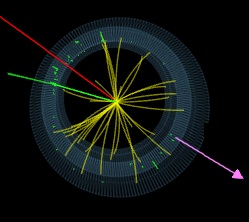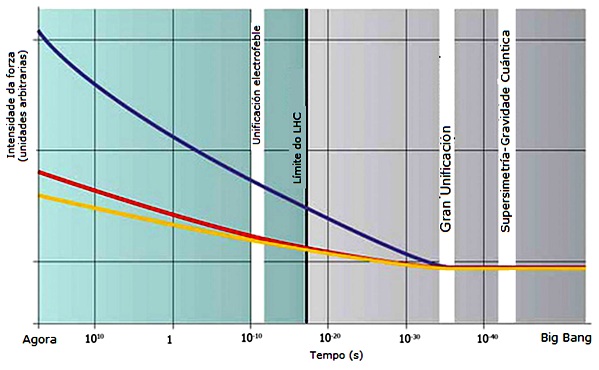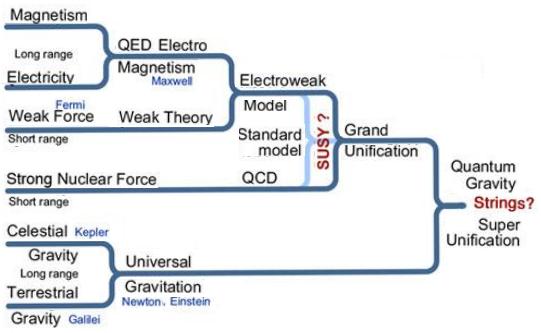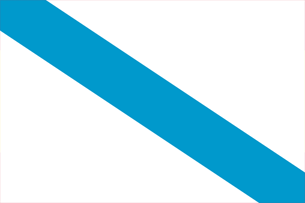Taking a closer look at LHC
Although the Standard Model has been very successful in accounting for all experimental phenomena, it is not expected to be the ultimate theory because of its great complexity and the many questions it leaves unanswered.
For example, if forces and matter particles are all there are, it says all particles must travel at the speed of light–but that is not what is being observed. To slow them down, is neccesary the Higgs field. In 2013, ATLAS e CMS, detectors in LHC, have shown the existence of this field.
It does not include the force of gravity and does not encompass the General Theory of Relativity.
Also, physicists now understand that 96 percent of the universe is not made of matter as we know it, and thus it does not fit into the Standard Model.
How to extend the Standard Model to account for these mysteries is an open question to be answered by current and future experiments.
As we indicated at the beginning of this section, the Standard Model cannot be the final theory of particle physics. There are several theoretical models that evade the limitations of the Standard Model, and their study is one of the goals of the LHC experiments (detectors).
For decades, so-called Supersymmetry Theories (SUSY) appeared as attempts to solve the constraints of the Standard Model. The essential idea was that for each type of particle there would be an associated - supercompanion - particle of large mass. This would be a boson replica if the "normal" particle is a fermion and vice versa.
Currently, these supersymmetry theories have been taken over by models involving "dark sectors", which include particles that are barely related to their Standard Model companions, making their detection very complex.
There are many variants of models with dark sectors, and each of them predicts different phenomenologies. One example is that of "long-lived" particles, which can fly macroscopic distances before disintegrating. We can generalise by pointing out that to find these particles requires either accumulating many collisions, since they occur very infrequently, or reaching very large collision energies, since their mass is much higher than that of the particles known so far.
One of the advantages of these dark sector models is that they typically include neutral, massive, almost non-interacting particles. Such particles are excellent candidates for dark matter. This, together with other more formal theoretical reasons, makes such models tremendously attractive.
In this dark sector of particle physics we could have a dark Higgs boson counterpart. Like the normal Higgs boson, this particle would be connected to the mechanism that gives mass to particles in the dark sector.
The energy currently available in proton-proton collisions at the LHC may be sufficient to produce this kind of particle according to such theoretical models. Three of the LHC's largest experiments (ATLAS, CMS and LHCb) have a very extensive search programme for dark-sector particles, designed to, if these theories are correct, detect their signal.

(Taken from https://cms.cern/news/
In the picture we have a visualisation of a particle collision event recorded at the CMS detector, with the initial collision of two protons, coming in opposite directions, occurring in the centre of the picture. As a result, a pair of high-energy charged leptons (a muon in red and an electron in green on the left side of the image) is created, resulting in a significant transverse momentum imbalance (pink arrow on the right side of the image), which would point in the direction in which the undetected dark matter particles could have gone.
The Search for Hidden Particles (SHiP) experiment.
Taken from ShiP Website
SHiP and the associated SPS Beam Dump Facility is a new general-purpose experiment in preparation at the accelerator SPS at CERN to search for "hidden" particles as predicted by a large number of models of Hidden Sectors that are capable of explaining for instance dark matter, neutrino oscillations, and the origin of the baryon asymmetry in the Universe. The experiment is design to search for any type of feebly interacting long-lived particles, among which are found e.g. heavy neutral leptons, dark photons , dark scalars, axion-like particles, and light supersymmetric particles, etc, as well as different types of Light Dark Matter.

The high intensity of the SPS and in particular the large production of charm mesons and photons with the 400 GeV proton beam allow a comprehensive search at the MeV-GeV scale over many orders of magnitude in coupling. The detector incorporates two complementary apparatuses aimed at searching for hidden particles through both visible decays and through scattering signatures from recoil of electrons or nuclei. Moreover, the facility is ideally suited to study the interactions of tau neutrinos.
The MADMAX experiment at CERN probes dark matter candidates.
Axions are a particles predicted by some theoretical physicists to explain why there is a subtle difference between matter and antimatter in processes involving the weak force, but not the strong force. If axions exist, they could be found in the centre of the Sun and they could also make up invisible dark matter.
In the last decade, physicists have explored several experimental approaches, such as the CERN Axion Solar Telescope, to search for axions. To date, no experiment has succeeded in finding them.
MADMAX (Magnetized Disk and Mirror Axion experiment) is a relatively young collaboration that started in 2017. Since 2020, CERN has provided the Morpurgo magnet to the experiment during technical stops, when the SPS beam is shut down. MADMAX benefits from a strong participation from across CERN for cryogenics, magnets, electrical power convertors, and safety and operations. It is one of the few experiments at CERN that are well suited for tests independent of beam time, as it does not require a particle beam from an accelerator.

If axions are discovered, it would have profound implications for the understanding of both particle physics and cosmology. Firstly, it would validate the existence of a new particle predicted by theorists more than 40 years ago, confirming the correct understanding of fundamental forces in the Universe. Secondly, since axions are considered a leading candidate for dark matter, their discovery could provide a direct explanation for this elusive substance that makes up a significant portion of the Universe.
The NA64 experiment searching for unknown particles from a hypothetical “dark sector”.
The NA64 experiment started operating at CERN's SPS North Area in 2016. It aims to search for unknown particles from the hypothetical ‘dark sector’.
This experiment uses a high-energy muon beam and a missing energy-momentum technique. Muons from the M2 beamline of CERN's Super Proton Synchrotron with a momentum of 160 GeV/𝑐 are directed at an active target.
NA64 Experiment (Image CERN)
NA64 is among the first experiments to search for dark sectors weakly coupled to muons. The experimenters hope to cover the available parameter space in the future using higher beam intensities.
In addition to particle accelerator experiments, there are other proposals for detecting dark matter based on the study of galactic dark matter, but we bring here a different attempt by physicists at the Department of Energy's (DOE) SLAC National Accelerator Laboratory (USA), who propose a new way to search for dark matter using quantum devices, which could be naturally tuned to detect what the researchers call "thermalised" dark matter.


|
AUTHORS Xabier Cid Vidal, PhD in experimental Particle Physics for Santiago University (USC). Research Fellow in experimental Particle Physics at CERN from January 2013 to Decembre 2015. He was until 2022 linked to the Department of Particle Physics of the USC as a "Juan de La Cierva", "Ramon y Cajal" fellow (Spanish Postdoctoral Senior Grants), and Associate Professor. Since 2023 is Senior Lecturer in that Department.(ORCID). Ramon Cid Manzano, until his retirement in 2020 was secondary school Physics Teacher at IES de SAR (Santiago - Spain), and part-time Lecturer (Profesor Asociado) in Faculty of Education at the University of Santiago (Spain). He has a Degree in Physics and a Degree in Chemistry, and he is PhD for Santiago University (USC) (ORCID). |
CERN CERN Experimental Physics Department CERN and the Environment |
LHC |
IMPORTANT NOTICE
For the bibliography used when writing this Section please go to the References Section
© Xabier Cid Vidal & Ramon Cid - rcid@lhc-closer.es | SANTIAGO (SPAIN) |



